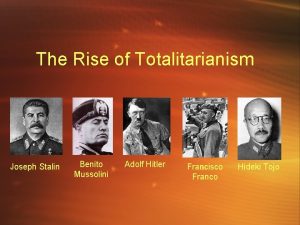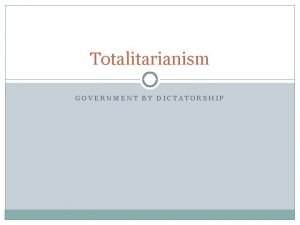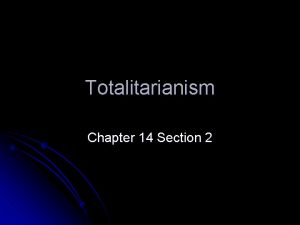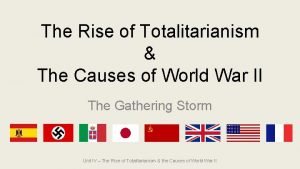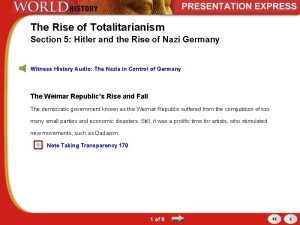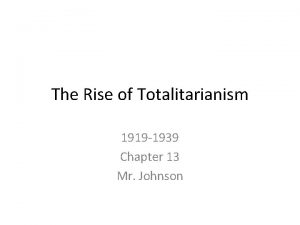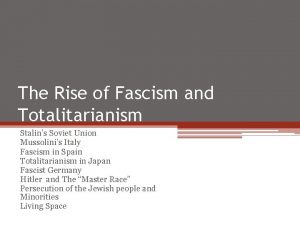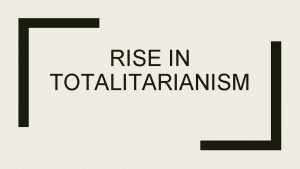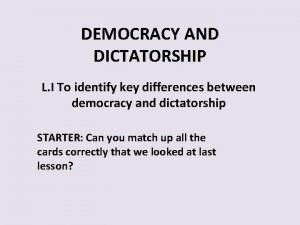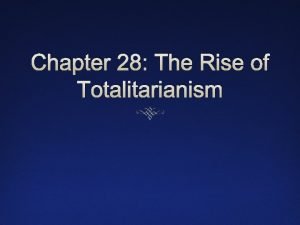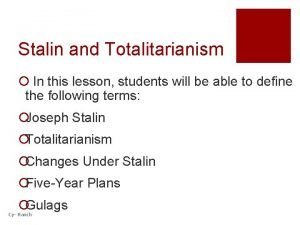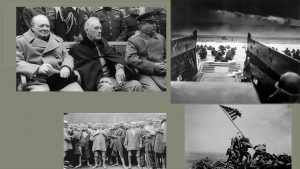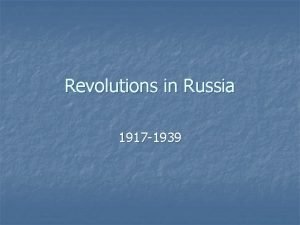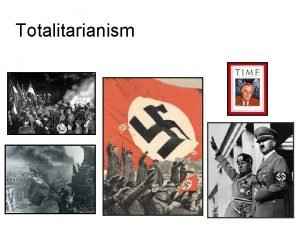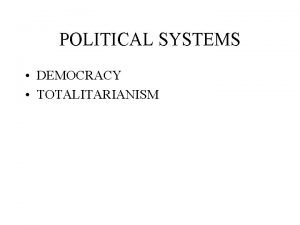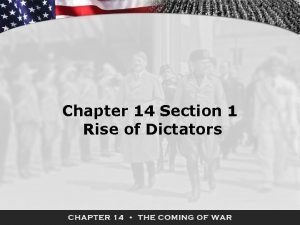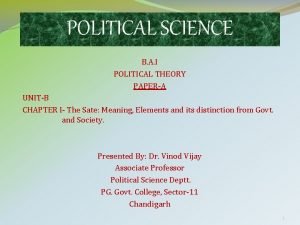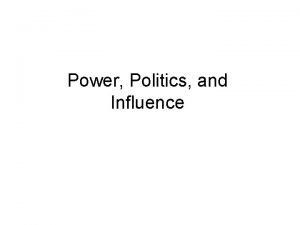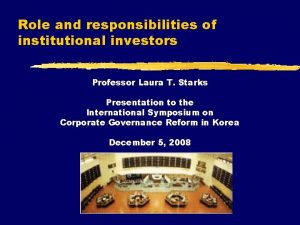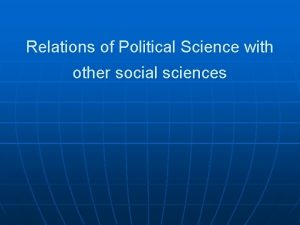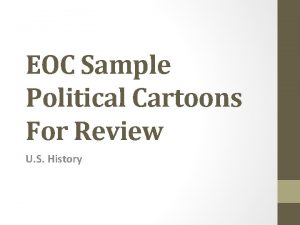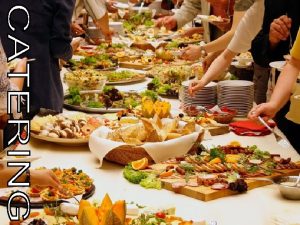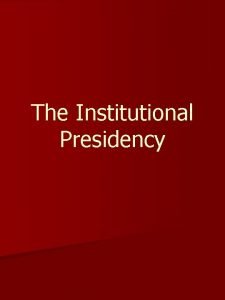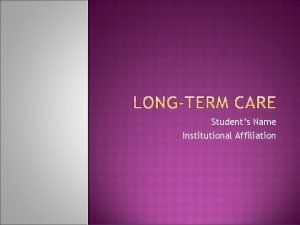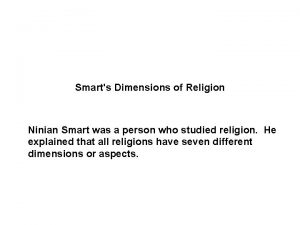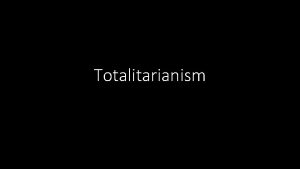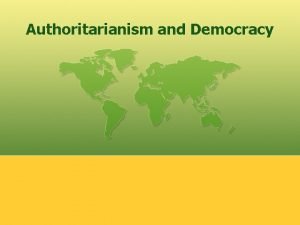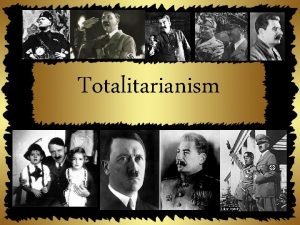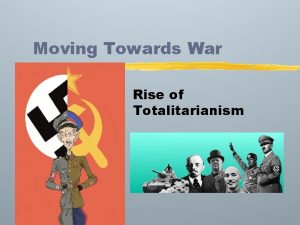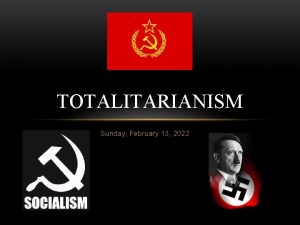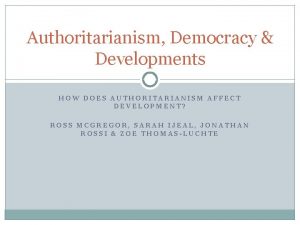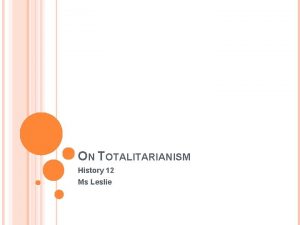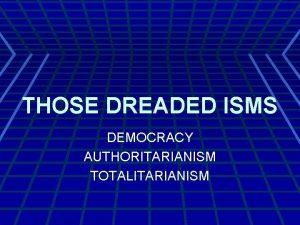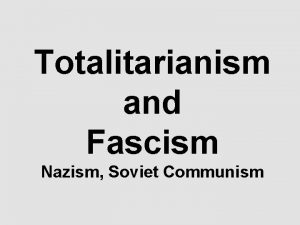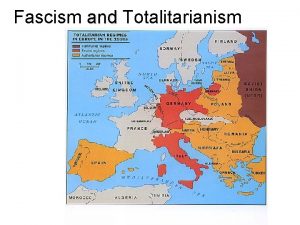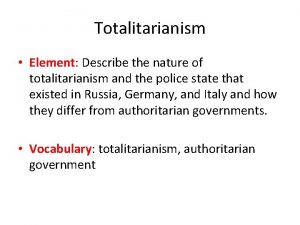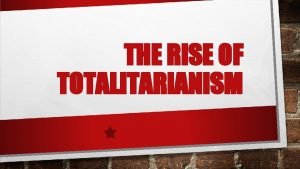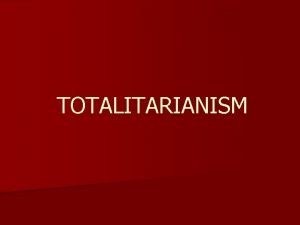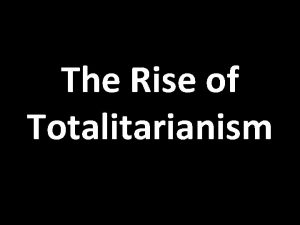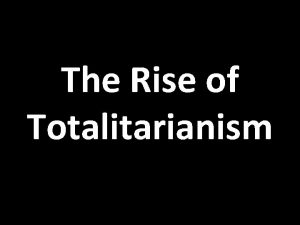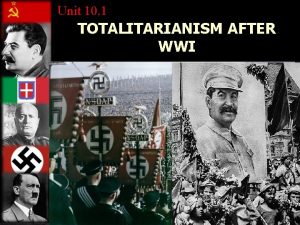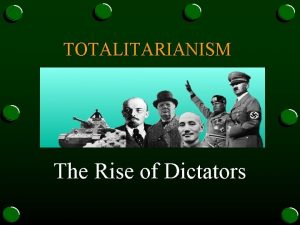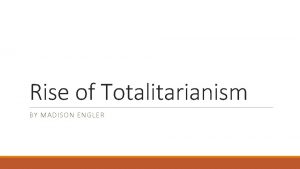Part I Political and Institutional History Totalitarianism Authoritarianism





































- Slides: 37

Part I: Political and Institutional History Totalitarianism Authoritarianism Single charismatic leader No charismatic leader Single dominant party Utopian, forward-looking ideology Nationalist and performance-based ideology State control over all organized activity political Emergence of nonprivate sphere Mobilized participation Apathy okay Popular fear instilled by arbitrary terror End of fear and arbitrary

Upcoming Topics Part II: Institutions 1: Institutions of the Party-State and State Capacity Can 2. Leadership Selection and Authoritarian Resiliance Central elite politics Local elections 3: Civil Society Can the state control its own agents? the state control society? 4: Media/Internet Politics Is the internet a virtual “civil society” and can the state

Upcoming Topics Part III: Governance Issues 1. Labor 2. Environment (DEBATE) 3. Inequality and Social Welfare 4. Religious and Ethnic Minorities 5. Nationalism 6. Taiwan

Institutions of the Party-State Major debate about the capacity of the Chinese state Defining terms State capacity +

Institutions of the Party-State Major debate about the capacity of the Chinese state Defining terms State capacity* Ability of state to penetrate society regulate social relationships extract resources use them in intended ways *Joel Migdal, Strong Societies and Weak States Pei’s terms: mobilizing political support, providing public goods, and managing internal tensions

Institutions of the Party-State Major debate about the capacity of the Chinese state Where does Pei Minxin stand? Alternative argument: Yang Dali +

Institutions of the Party-State Major debate about the capacity of the Chinese state Where does Pei Minxin stand? Alternative argument: Yang Dali* China has made significant institutional reforms to improve governance Critique: strong on policy; weak on implementation *Remaking the Chinese Leviathan Now let’s look at some empirical evidence to assess the relative merits of each side in the debate.

Institutions of the party-state 8 1) How is the party-state structured? 2) What are the mechanisms of party control?

9 Review: Chinese Communist Party parallels and dominates all other state institutions (Stay tuned for more on interest representation by NPC and Local Peoples’ Congresses)

Review: 5 Levels of Government; 6 Levels of Party 10 Central level Provincial level Municipal /prefectural level County level Township level (lacks full complement of government offices) Village (party only) (more on village elections in Session #12)

Institutions of the party-state 11 What are the mechanisms of Leninist party control? Democratic centralism Party discipline Applies to 82 million party members (~5 -6% of population) Central Commission for Discipline Inspection Monitors corruption within party Harvard’s Samuel Huntington (Dali Yang, p. 49) “Organization is the road to political power, but it is also the foundation of political stability and thus the precondition of political liberty. ” Love to hate?

Institutions of the party-state 12 What are the mechanisms of Leninist party control within and beyond the CCP? Nomenklatura List of positions for which party vets candidates Examples beyond the party itself +

Institutions of the party-state 13 What are the mechanisms of Leninist party control within and beyond the CCP? Nomenklatura List of positions for which party vets candidates Examples beyond the party itself Government executives Standing Committees of People’s Congresses Editors of major newspapers University leadership Trade Union leadership Buddhist Association, Chinese Catholic Church leadership Lawyer’s Association leadership State-owned corporation leadership

Institutions of the party-state 14 What are the mechanisms of Leninist party control within and beyond the CCP? “Double-hatting” Concurrent Village head and village party secretary concurrently “Interlocking Example: party and other positions directorates” Ma Wen Minister, Ministry of Supervision (government) Deputy Secretary, Central Commission for Discipline Inspection (CCP) Party core groups and party committees Example: Party group (党组) in leadership of local People’s Congress Must follow party line

Institutions of the party-state 15 Problems with Leninist party leadership: competing sources of authority Vertical-horizontal relations (tiao-kuai guanxi 条块关系) Examples: Horizontal: territorial governments like a county Vertical: substantive agencies County party secretary is ultimate local authority (一把手) National tax office (国税局) at county level Environmental protection agency at county level People’s Bank county-level branch Local Communist Party secretaries often hold sway over bureaucrats in the local offices of central agencies Ex: local environmental protection bureau Less likely to implement the policies of the State Environmental Protection Agency if the local CCP party secretary cares more about industrial output and jobs then clear air or water

Institutions of the party-state 16 Premise: What do local leaders (cadres) care about? Political careers Leading cadre evaluation system Specific, measurable, quantifiable criteria Linked to “high-powered” incentives Promotion prospects Determined by performance on key targets Bonuses (often as much as the base salary itself) Important for signaling the priorities of higher levels Shifting emphasis—demonstrates political learning Economic: output sales Economic political With privatization, cadres directly manage fewer enterprises With “losers” emerging during the later reform process, more protests, seen as threats to CCP control

Institutions of the party-state How to conceptualize cadre management? Principal-agent problem Who are the principals? Who are the agents? What are the defining characteristics of the principal-agent problem?

Institutions of the party-state Principal-agent problem Defining Interest characteristics conflict Information asymmetry

Institutions of the party-state Principal-agent problem Analytical “Moral insights hazard” Performing only to measured criteria Investment in environmental infrastructure Equipment subsequently disabled

Institutions of the party-state Leading cadre evaluation system as a principal -agent problem: gaming the system Early example (GVIO 业总产值) Politically Current motivated bank loans to local enterprises example (Investment 招商引资) Manipulate requisitions of rural land for development Contrast Dali Yang p. 48 (auctions) QUESTION: Dali Yang: “rent seeking”

Institutions of the party-state Principal-agent problem Analytical insights Multitask problem Difficult to promote multiple targets simultaneously Example: environmental protection targets vs. growth/investment

Institutions of the party-state Principal-agent problem What does this framework miss analytically?

Institutions of the party-state 23 Questions for discussion: What aspects of the system promote effective policy implementation? What are the structural obstacles to effective governance? To whom are local cadres accountable?

Fiscal Policy in State Capacity 24 Why is central fiscal capacity important? Is Dali Yang’s optimism justified? p. 44

Fiscal Policy Background 1994 tax and fiscal reforms Established National Tax Service Collects central and shared taxes Leaves local taxes to be collected by Local Tax Service Stemmed fiscal crisis Budgetary revenue as share of GDP (pdf) 1994 10. 8 percent 2005 17. 3 percent Centralized Center’s control over fiscal revenue share of budgetary revenue increased (pdf) 1993 = 22 percent Since 1994 > 50 percent 25

Fiscal Policy Background 1994 tax and fiscal reforms However, continued decentralized expenditure responsibility Implications for local governments 26

Implications of Fiscal Policy Fiscal gap 40 -45 percent covered by local and shared taxes 40 -50 percent of fiscal needs covered by intergovernmental fiscal transfers 5 -10 percent of fiscal needs unmet (Wang Yongjun estimate 2006) 27

Central-local regular intergovernmental fiscal transfers (equalizing)

Intergovernmental fiscal transfers to support rural tax/fee reform (equalizing)

Earmarked intergovernmental fiscal transfers (often disequalizing)

Implications of Fiscal Policy Source: Rozelle (Stanford)

Implications of Fiscal Policy Source: Rozelle (Stanford)

Implications of Fiscal Policy Source: Rozelle (Stanford)

Implications of Fiscal Policy Source: Rozelle (Stanford)

Implications of Fiscal Policy

Implications of Fiscal Policy High degree of dependence on fiscal transfers for local governments Only some are equalizing More transfers directed to poorest areas after 2004 Reliance on off-budget funds and local government debt Use land to generate local tax revenues Exacerbated by political pressures (tenure, promotion criteria), unfunded mandates 36

Fiscal Policy in State Capacity 37 Why is central fiscal capacity important? Is Dali Yang’s optimism justified? p. 44
 Rise of totalitarianism
Rise of totalitarianism Pros and cons of totalitarian
Pros and cons of totalitarian Chapter 14 section 2 totalitarianism
Chapter 14 section 2 totalitarianism Causes of pearl harbor
Causes of pearl harbor The rise of totalitarianism section 5 quiz
The rise of totalitarianism section 5 quiz Chapter 13 the rise of totalitarianism
Chapter 13 the rise of totalitarianism Fascism vs totalitarianism
Fascism vs totalitarianism Totalitarianism vs fascism
Totalitarianism vs fascism Democracy and dictatorship venn diagram
Democracy and dictatorship venn diagram Chapter 28 section 3 fascism in italy
Chapter 28 section 3 fascism in italy Democracy pictoword
Democracy pictoword Fascism vs totalitarianism
Fascism vs totalitarianism Totalitarianism lesson plan
Totalitarianism lesson plan Holocaust bell ringers
Holocaust bell ringers Traits of totalitarianism
Traits of totalitarianism Russian totalitarianism
Russian totalitarianism Totalitarianism
Totalitarianism Secular totalitarianism
Secular totalitarianism Chapter 14 section 2 totalitarianism
Chapter 14 section 2 totalitarianism Political science and psychology
Political science and psychology Factors contributing to organizational politics
Factors contributing to organizational politics Institutions supporting entrepreneurship
Institutions supporting entrepreneurship Roles and importance of institutional investors
Roles and importance of institutional investors Difference between sociology and political science
Difference between sociology and political science This 1924 cartoon satirizes a scandal that led to
This 1924 cartoon satirizes a scandal that led to Part whole model subtraction
Part whole model subtraction Part to part ratio definition
Part to part ratio definition Brainpop ratios
Brainpop ratios Technical object description example
Technical object description example Bar die, foot rail and bar counter are the parts of?
Bar die, foot rail and bar counter are the parts of? The part of a shadow surrounding the darkest part
The part of a shadow surrounding the darkest part Two way anova minitab 17
Two way anova minitab 17 Wisconsin long term care partnership program
Wisconsin long term care partnership program Examples of institutional catering
Examples of institutional catering Institutional presidency definition
Institutional presidency definition Eu institutional triangle
Eu institutional triangle Institutional affiliation definition
Institutional affiliation definition Ninian smart religion
Ninian smart religion
